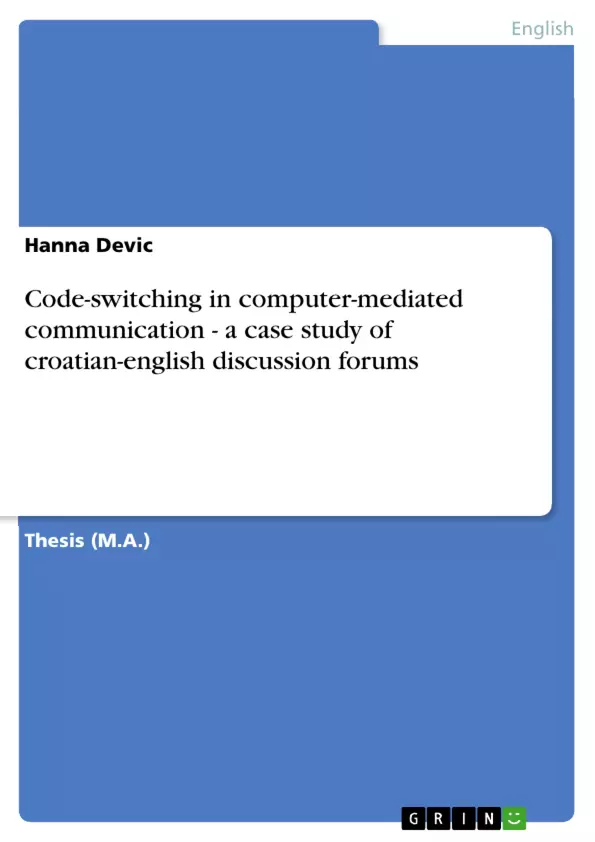It has now been about a decade and a half since the Internet and the World Wide Web have come to represent a major realm of research in various fields of linguistics. This is of course largely due to the fact that they offer easy access to a massive and unlimited amount of language data, which do not have to be transcribed in arduous ways as is the case with speech recordings. However, alongside this major cause of attraction, and despite the overall dominance of English, it is also the multilingual nature of the Internet which has naturally sparked the interest of bilingualism research as well as language contact research. It is the choice of and the switching between the available codes of the users' repertoires which mark a major topic of interest, and which shall be explored in the thesis at hand. The final focus of investigation will be the communicative functions and meanings of the phenomenon called code-switching (CS) as it naturally occurs in a Canadian-Croatian discussion forum.
Inhaltsverzeichnis (Table of Contents)
- 1. INTRODUCTION
- 2. CODE-SWITCHING AS A FIELD OF RESEARCH
- 2.1. The Object of Research
- 2.2. The Origins of Code-switching Research
- 2.3. The Research History
- 3. MAJOR EXPLANATORY FRAMEWORKS
- 3.1. Gumperz: Situation – Metaphor – We and They
- 3.2. Myers-Scotton and the Markedness Model
- 3.3. Auer and the Conversationalist Approach
- 4. LANGUAGE AND THE INTERNET
- 4.1. Computer-mediated Communication and Language Use
- 5. CS RESEARCH IN COMPUTER-MEDIATED SETTINGS
- 5.1. Paolillo and the Indian Diaspora
- 5.2. Georgakopoulou and Greek-English E-mail Discourse
- 5.3. Androutsopoulos and German-Based Web Forums
- 5.4. Hinrichs: English and Jamaican Creole in E-mail Communication
- 6. THEORY IN Practice
- 6.1. The Corpus
- 6.2. The Users
- 6.3. Methodology
- 6.4. Analysis
- 6.4.1. Prior expectations versus actual language use
- 6.4.2. Conversational loci and linguistic structures susceptible to CS
- 6.4.3. Referential code-switching
- 6.4.4. Directive code-switching
- 6.4.5. Metaphoric code-switching
- 6.4.6. 'Poetic' code-switching
- 6.4.7. Expressive code-switching
- 6.5. Summary of findings
- 7. CONCLUSION
- 8. SOURCES
- 9. APPENDIX – THE DATA
- 10. APPENDIX - GERMAN SUMMARY
Zielsetzung und Themenschwerpunkte (Objectives and Key Themes)
This research thesis focuses on the phenomenon of code-switching (CS) in computer-mediated communication (CMC), specifically examining its communicative functions and meanings within a Canadian-Croatian online discussion forum. The paper aims to provide a theoretical framework for analyzing CS in CMC by exploring classic linguistic approaches and their application to the chosen corpus. The work also delves into the historical and contemporary research surrounding CS, including relevant studies on CS in CMC settings. Key themes addressed throughout the paper include: * **Code-switching as a linguistic phenomenon:** The paper defines code-switching and examines the various terms and concepts used to describe it. * **Theoretical frameworks for analyzing code-switching:** The paper explores different theoretical approaches to understanding code-switching, such as Gumperz's situational model, Myers-Scotton's markedness model, and Auer's conversationalist approach. * **Language and the Internet:** The paper investigates the impact of the Internet on language use and the specific features of language in computer-mediated communication. * **Code-switching in computer-mediated communication:** The paper examines existing research on code-switching in CMC, highlighting various case studies and their findings. * **Analysis of a Canadian-Croatian discussion forum:** The paper presents a detailed analysis of code-switching practices within a specific online forum, considering the backgrounds of the participants and the context of the forum posts.Zusammenfassung der Kapitel (Chapter Summaries)
The paper begins by introducing the topic of code-switching and its significance within the realm of linguistics and internet research. It highlights the complexities associated with defining code-switching and its various manifestations across different academic fields. The subsequent chapter examines existing research on code-switching, outlining its origins and historical development. Major explanatory frameworks, such as Gumperz's situational model, Myers-Scotton's markedness model, and Auer's conversationalist approach, are explored in detail, highlighting their strengths and limitations. The paper then transitions to the intersection of language and the internet, focusing on the specific characteristics of language use within computer-mediated communication settings. It explores the relationship between code-switching and various forms of online communication, drawing on case studies that highlight the diverse ways in which code-switching functions in different online communities. The paper then examines the Croworld corpus, a Canadian-Croatian discussion forum that serves as the primary source for the analysis. The backgrounds of the forum participants and the structure of the forum posts are detailed, providing contextual information for the subsequent analysis. The final chapter presents a detailed analysis of selected forum posts, focusing on how code-switching is employed within the chosen online community. The analysis examines different types of code-switching, such as referential, directive, metaphoric, 'poetic,' and expressive code-switching. The chapter highlights the linguistic structures and conversational dynamics that influence code-switching practices, emphasizing the significance of the online context.Schlüsselwörter (Keywords)
This research explores the field of code-switching, examining its role in computer-mediated communication. The primary focus is on analyzing communicative functions and meanings within a Canadian-Croatian online discussion forum. Key terms and concepts include code-switching, computer-mediated communication, linguistic theory, research methodologies, online communities, and cultural dynamics. The paper explores various theoretical frameworks for understanding code-switching, such as Gumperz's situational model, Myers-Scotton's markedness model, and Auer's conversationalist approach.- Quote paper
- Magistra Artium Hanna Devic (Author), 2007, Code-switching in computer-mediated communication - a case study of croatian-english discussion forums, Munich, GRIN Verlag, https://www.grin.com/document/115170



